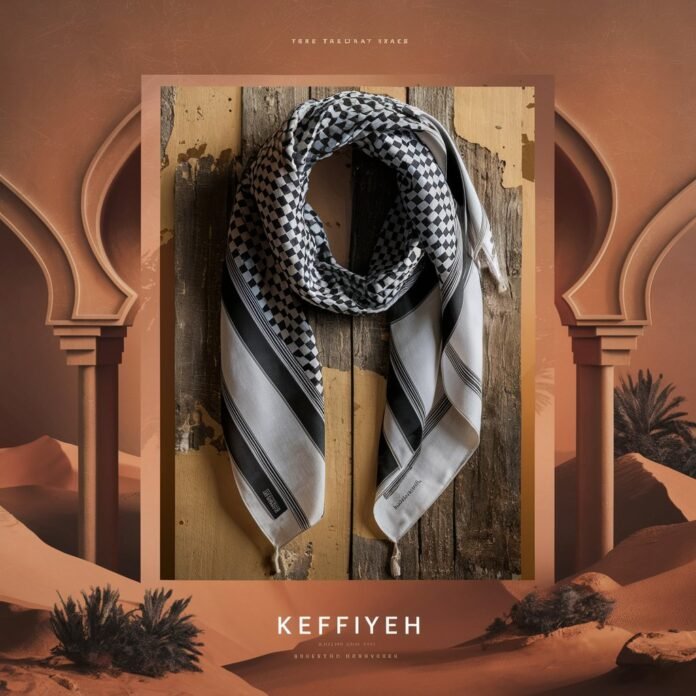The keffiyeh, also known as a shemagh or ghutra, is a distinctive checkered scarf traditionally worn in the Middle East. While it may appear to be a simple accessory, the keffiyeh carries deep cultural, historical, and political significance. Over time, it has transcended its origins to become a global symbol of identity and resistance. This article will explore the rich history of the keffiyeh, its cultural importance, and its role in modern fashion and politics.
The keffiyeh is a traditional checkered scarf made of cotton, commonly worn in various parts of the Middle East.
Table of Contents
- Introduction
- What is a Keffiyeh?
- Overview of Its Traditional Use
- Historical Origins of the Keffiyeh
- Ancient Roots in the Middle East
- Arab History
- Cultural Significance
- Symbolism in Arab Culture
- The Keffiyeh as a Political Symbol
- Modern Times
- Global Fashion
- The Controversy Surrounding Its Use
- How to Wear a Keffiyeh
- Traditional Methods
- Modern Variations
- The Keffiyeh in Popular Culture
- Celebrities
- Art and Media
- FAQs
- Conclusion
Introduction
What is a Keffiyeh?
The keffiyeh, often referred to as a shemagh or ghutra, is a square-shaped scarf, traditionally made from cotton, that features a distinctive checkered pattern. It is commonly worn in various parts of the Middle East, including Palestine, Jordan, and Iraq, and has been a staple of Arab culture for centuries. The keffiyeh is not just a piece of clothing but a symbol that represents a rich cultural heritage.
Overview of Its Traditional Use
Traditionally, they served practical purposes, such as providing protection from the harsh sun, sand, and wind in desert environments. It was worn by farmers, villagers, and Bedouins alike and became an integral part of daily life in the Middle East. The way the is worn can vary, with different styles signifying regional and tribal affiliations.
Historical Origins of the Keffiyeh
Ancient Roots in the Middle East
The origins of the can be traced back thousands of years. It is believed to have originated in Mesopotamia, where it was worn by the Sumerians and Babylonians. The distinctive checkered pattern, now synonymous with the keffiyeh, may have been derived from ancient weaving techniques passed down through generations.
Arab History
They became more widely recognized as a symbol of Arab identity during the early 20th century. It was during the Arab Revolt against the Ottoman Empire (1916-1918) that the keffiyeh gained prominence as a symbol of resistance and unity. Arab leaders and revolutionaries, including T.E. Lawrence (Lawrence of Arabia), were often seen wearing, further cementing its status as a symbol of Arab nationalism.
Cultural Significance
Symbolism in Arab Culture
In Arab culture, is more than just an article of clothing. It is a symbol of honor, pride, and resilience. The different colors and patterns of keffiyehs can represent various regions or political affiliations. For example, the black-and-white keffiyeh is often associated with Palestine and has become a symbol of Palestinian identity and resistance.

The Keffiyeh as a Political Symbol
The keffiyeh’s role as a political symbol cannot be understated. It became globally recognized during the Palestinian struggle for independence in the mid-20th century. Palestinian leader Yasser Arafat was rarely seen without his black-and-white keffiyeh, which became synonymous with the Palestinian cause. Today is still worn by activists and supporters of Palestinian rights worldwide, making it a powerful symbol of resistance and solidarity.
Modern Times
Global Fashion
In recent years, the keffiyeh has crossed cultural boundaries and entered the realm of global fashion. Designers and fashion enthusiasts have adopted it, incorporating it into various styles and trends. While this has brought the keffiyeh into mainstream fashion, it has also sparked debates about cultural appropriation and the loss of its original meaning.
The Controversy Surrounding Its Use
The widespread adoption of them in fashion has led to controversy, particularly when worn without an understanding of their cultural and political significance. Some view the commercialization of the keffiyeh as a form of cultural appropriation, stripping it of its historical and political context. This has sparked conversations about the importance of respecting and preserving cultural symbols.
How to Wear a Keffiyeh
Traditional Methods
The traditional way to wear a involves folding it into a triangle and draping it over the head or around the neck. In many Arab countries, it is worn to shield the face from the sun and sand. The style can vary depending on the region and the wearer’s intention. For example, the Bedouin style involves tying the ends of the at the back of the head, while in Palestine, it is often worn with one side draped over the shoulder.
Modern Variations
In modern fashion, the is often worn as a scarf or shawl. It can be styled in various ways, from loosely draped around the neck to intricately wrapped as a headscarf. The versatility of the keffiyeh has made it a popular accessory in both casual and formal wear, appealing to a diverse audience.
The Keffiyeh in Popular Culture
Celebrities
They have made appearances in popular culture, with celebrities and public figures incorporating it into their wardrobes. This has further increased its visibility and popularity but has also led to mixed reactions from those who view it as a symbol of political struggle rather than a fashion statement.
Art and Media
Artists and filmmakers have used the as a symbol in their work, often to make statements about identity, resistance, and solidarity. It has been featured in various forms of media, from movies to music videos, highlighting its significance as both a cultural and political icon.
FAQs
Q: What is the significance of the checkered pattern?
A: The checkered pattern on a is believed to have ancient origins, possibly linked to traditional weaving techniques in the Middle East. It has since become a symbol of Arab identity and resistance.
Q: Is it appropriate for non-Arabs to wear a keffiyeh?
A: While the has become a global fashion accessory, it is important to understand its cultural and political significance. Wearing without this awareness can be seen as disrespectful or as cultural appropriation.
Q: How do you properly wear?
A: Traditionally, a is folded into a triangle and draped over the head or neck. The style can vary depending on the region and purpose, such as protection from the elements or as a symbol of solidarity.
Q: What does the color of a keffiyeh signify?
A: The color and pattern can signify different regions, tribes, or political affiliations. For example, the black-and-white keffiyeh is often associated with Palestine.
Conclusion
The is far more than just a piece of fabric; it is a symbol of identity, resistance, and cultural heritage. From its ancient origins in the Middle East to its modern-day presence in global fashion, the has remained a powerful emblem of pride and resilience. Understanding the significance of the and wearing it with respect is essential to preserving its legacy and meaning.
By delving into the history, cultural significance, and modern relevance, this article aims to provide a comprehensive understanding of this iconic symbol. Whether you are interested in its historical roots, its role in politics, or its place in fashion, the is a testament to the enduring power of cultural symbols in a globalized world.




